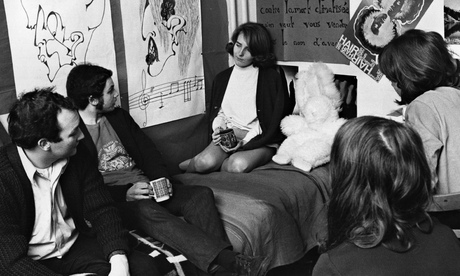
Linda Grant's sixth work of fiction is a fast-moving book, set mostly in loose, hedonistic, tactile times – the early 1970s – but it has an icy edge. This edge can be attributed to Adele, its narrator. "You seemed tough to me, like overcooked meat," a friend says retrospectively of Adele's character as a teenager. Another describes her "rather hard, closed face above" her "reedy body". Adele doesn't like pets, sees being "nice" as a feeble quality, and always keeps herself at a slight distance from the partying and revolutionary posturing of her peers. Being in her presence can make reading Upstairs at the Party feel a bit like being reluctantly invited into a house by a busy person for a cup of tea, but her coolness is understandable – her dad committed suicide when she was in her early teens – and her slightly removed perspective arguably makes her a more reliable commentator on the hippy era than a drug casualty or quasi-eastern mystic radical who threw themselves more blindly into it.
Fresh from working on a perfume counter in Liverpool, Adele talks her way across northern Britain into a futuristic, brutalist university (a campus that is York, in all but name). "I came at it as if I'd shot myself from a cannon aimed across a river at a fortified target," she says. She meets advocates of sexual experimentation, such as her friend Bobby, and glamorous couples, such as the androgynous Stevie and Evie, who seem to have been reborn from the beginning of their first term, renouncing their old humdrum identities and walking around with an impermeable sheen of charisma. Later, though, she realises that she has become "a lab rat in a giant social experiment". The students of her time have their education paid for by the government and an enormous amount of free time but one senses their futures are in irresponsible, less than supportive hands – especially during the tragic, central event to which the book's title alludes. This event leaves its mark on almost all of its main characters – not least Adele. Some of them, however, seem no less damaged by the misguided impulses of the time they grew up in. Some of the book's less obviously tragic stories are actually more sadly touching. Gillian, for example, the most good-natured of Adele's friends, is a promising viola player who swaps the instrument for revolutionary politics and never really seems to make her way back to herself again.
Often, Upstairs at the Party feels like a darker, more cynical version of Kate Atkinson's Emotionally Weird (another, much more playful semi-autobiographical novel set at a northern university in the early 70s). There was no doubt that Effie, the narrator of Emotionally Weird, felt affection for the time of her youth, but any that Adele feels is more complex and barbed, or at least slower to surface. She thinks the music of the era, glam rock, is "dire" and pays almost no attention to its news and politics, yet she seems more fascinated with how it has shaped her the older she gets. Towards the book's end, when she meets up with the most political of her university acquaintances, Brian, she's surprised at his dismissal of all that he used to stand for, and his inability to remember a pivotal event in all of their lives.
Upstairs at the Party races through the era that holds its fascination painfully quickly, leaving you somehow aware of the fleeting passage of youth all the more in the process. By the book's halfway point, we're in 1991 – a time that smells to Adele of "plastic taxi seats" in great contrast to 1974's aroma of "patchouli oil and Old Holborn tobacco and long hair singed on the bars of an electric fire" – and moving swiftly on. But right from the beginning, this is a story told in a voice very clearly from the present. Certainly, it is concerned with the impact of one event in Adele's youth, but its chief interest is the larger difference between then and now. In the early chapters, Adele already speaks of the sense that the gadgets of the modern age have become for adults like the "harnesses and reins" people attach to toddlers. "Odd, that we clamoured for freedom and already had it," she says of the 70s, "in the form of out-of-order telephone boxes and second-class postal delivery."
This is perhaps why Upstairs at the Party is a very good book: it creates a sense of yearning through a cloud of scepticism. You emerge from it battered and bruised, and not entirely sure you wanted to be in 1974, but wishing you had the space its characters had in their lives: their freedom to be completely in their moment, however absurd and pretentious that moment happened to be.

